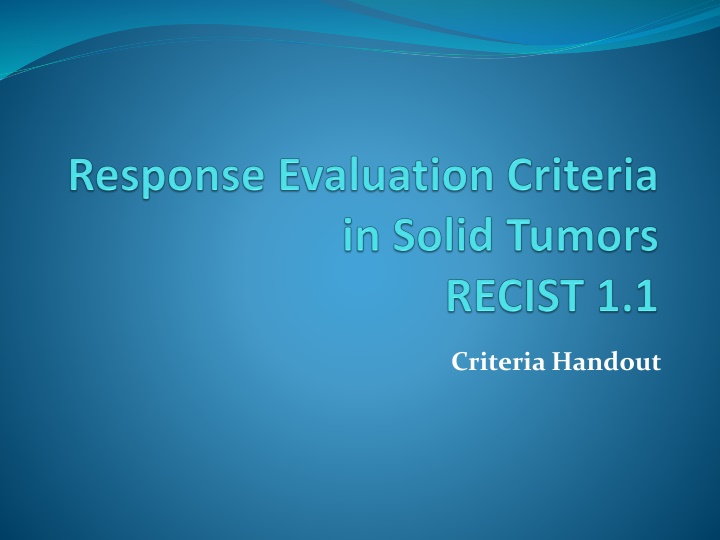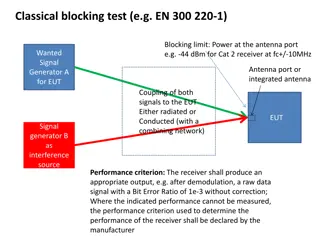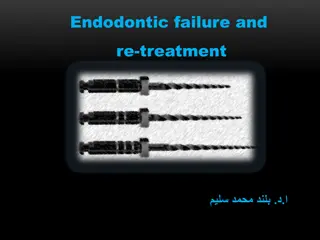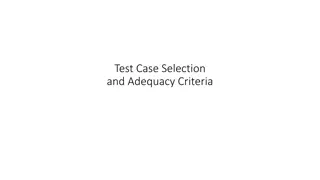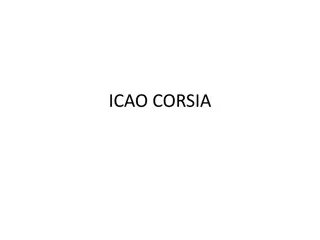Criteria Handout
This handbook provides detailed guidelines on assessing measurable and non-measurable lesions, recording baseline lesion burden, and selecting target lesions for evaluation. It covers criteria for different lesion types, including tumor, lymph nodes, and special lesions like bone and cystic lesions. The process involves assessing, measuring, and evaluating lesions over time for response calculation in medical imaging. The handbook ensures standardized lesion evaluation and monitoring procedures for medical professionals.
Download Presentation

Please find below an Image/Link to download the presentation.
The content on the website is provided AS IS for your information and personal use only. It may not be sold, licensed, or shared on other websites without obtaining consent from the author.If you encounter any issues during the download, it is possible that the publisher has removed the file from their server.
You are allowed to download the files provided on this website for personal or commercial use, subject to the condition that they are used lawfully. All files are the property of their respective owners.
The content on the website is provided AS IS for your information and personal use only. It may not be sold, licensed, or shared on other websites without obtaining consent from the author.
E N D
Presentation Transcript
Basic Paradigm Assess at baseline Look for measurable lesions Select target and non-target lesions Measure target lesions Follow-up evaluation Measure target lesions Assess non-target lesions and look for new lesions Calculate timepoint response
Measurable Lesions Tumor 10 mm in longest diameter (LD) on an axial image on CT or MRI Lymph nodes 15 mm in short axis on CT Lymph node measurements: specific instructions: short axis 15 mm is measurable 10-14 mm is abnormal (recorded as non-target) <10 mm is considered normal Ultrasound cannot be used to measure lesions
Non-Measurable Lesions All other definite tumor lesions Masses <10 mm Lymph nodes 10-14 mm in short axis Leptomeningeal disease Ascites, pleural or pericardial effusion Inflammatory breast disease Lymphangitic involvement of skin or lung
Special Lesion Types Bone Lesions Bone lesions with identifiable soft tissue components seen on CT or MR can be measurable if the soft tissue component meets the definition above Blastic bone lesions are unmeasurable
Special Lesion Types Cystic Lesions Simple cysts are not included as lesions Cystic metastases may be selected, but prefer to use non-cystic lesions as target
Target Lesions Record a maximum of five (5) target lesions in total Up to two (2) per organ Any combination of organ masses or lymph nodes, but representative of all involved organs Select largest reproducibly measurable lesions If the largest lesion cannot be measured reproducibly, select the next largest lesion which can be
Lymph Node Measurements Measure short axis 15 mm is measurable (may be recorded as target) 10-14 mm is abnormal (recorded as non-target) <10 mm is considered normal
Non-Target Lesions It is possible to record multiple non-target lesions involving the same organ as a single item (e.g. multiple enlarged pelvic lymph nodes or multiple liver metastases )
Evaluation on Follow-up Measure previously chosen target lesions Even if they are no longer the largest If a target lesion fragments into multiple smaller lesions, the LDs of all fragmented portions are measured If target lesions coalesce, the LD of the resulting coalescent lesion is measured Evaluate all previously identified non-target lesions Look for new definite cancer lesions
New Lesions Should be unequivocal and not attributable to differences in scanning technique or findings which may not be a tumor Does not have to meet criteria to be measurable Lesions identified in anatomic locations not scanned at baseline are considered new New lesions on US should be confirmed on CT/MRI
